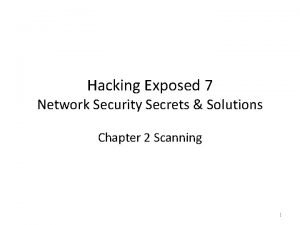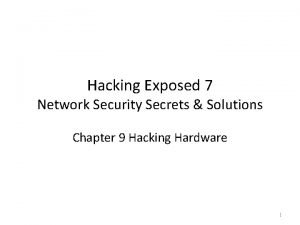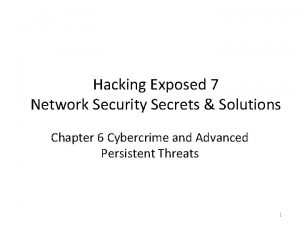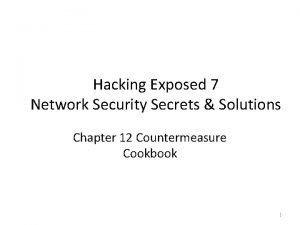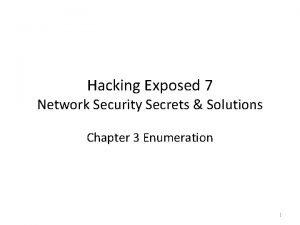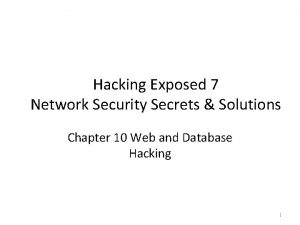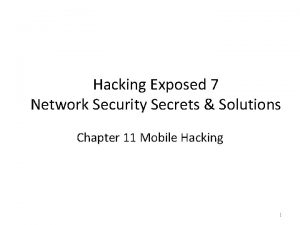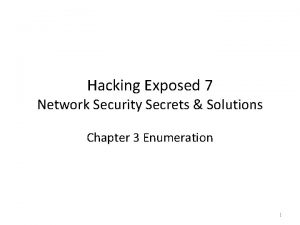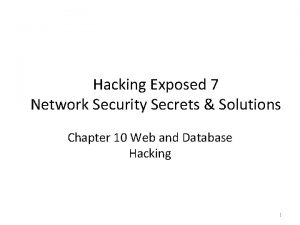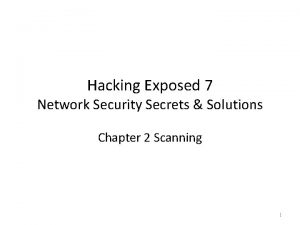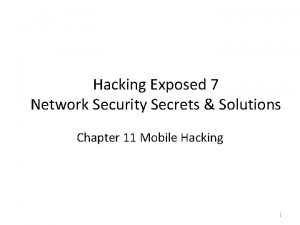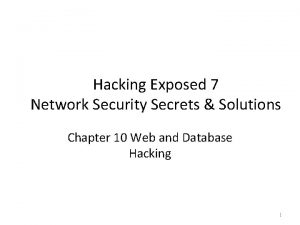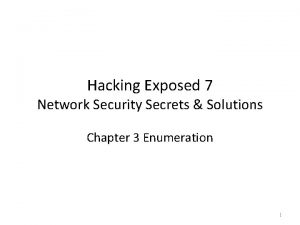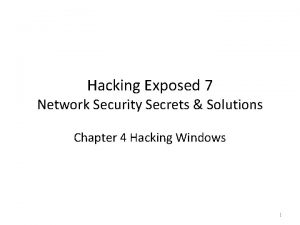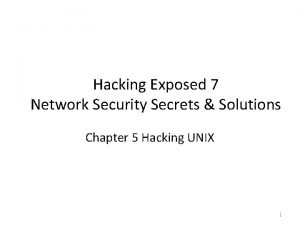Hacking Exposed 7 Network Security Secrets Solutions Chapter



















- Slides: 19

Hacking Exposed 7 Network Security Secrets & Solutions Chapter 7 Remote Connectivity and Vo. IP Hacking 1

Remote Connectivity and Vo. IP Hacking • • • Dial-up Hacking PBX (Private Branch Exchange) Hacking Voicemail Hacking Virtual Private Network (VPN) Hacking Voice Over IP (Vo. IP) Attacks 2

Dial-up Hacking Preparing to Dial up • Many companies still use dial-up connections – Connecting to old servers, network devices, Industrial control system (ICS) • Dial-up hacking process is similar to other hacking – Footprint, scan, enumerate, exploit – Automated by tools: wardialer or demo dialer • Phone number footprinting: identify blocks of phone numbers to load into a wardialer – Phone directories, target websites, Internet name registration database, manual dialing, etc. – Countermeasures: require a password to make account inquiries; sanitize sensitive information; educate employees 3

Dial-up Hacking Wardialing • Hardware – Important as the software, greatly affect efficiency • The number of modems, high-quality modems • Legal issues – Laws about wardialing activities • Identify phone lines, record calls, spoof phone numbers, etc. • Peripheral costs – Long distance, international or nominal charges • Software – Automated scheduling, ease of setup, and accuracy – Tools: War. VOX, Tele. Sweep, Phone. Sweep 4

Dial-up Hacking Brute-Force Scripting - The Homegrown way • Categorize the connections into penetration domains – Based on wardialing results – Experience with a large variety of dial-up servers and OS • Brute-force scripting attack: ZOC, Procomm Plus, and ASPECT scripting language Domains Attacking remarks Low Hanging Fruit Easily guessed or commonly used passwords Single Authentication, Unlimited Attempts ONE type of authentication (password or ID) NOT disconnect after a number of failed attempts Single Authentication, Limited Attempts ONE type of authentication (password or ID) Disconnect after a number of failed attempts Dual Authentication, Unlimited Attempts TWO type of authentication (password and ID) NOT disconnect after a number of failed attempts Dual Authentication, Limited Attempts TWO type of authentication (password and ID) Disconnect after a number of failed attempts 5

Dial-up Hacking Dial-up Security Measures 1. 2. 3. 4. 5. 6. 7. 8. 9. Inventory existing dial-up lines Consolidate all dial-up connectivity to a central modem bank – Position as an untrusted connection off the internal network Make analog lines harder to find Verify that telecommunications equipment closets are physically secure Regularly monitor existing log features within dial-up software For business serving lines, do not disclose any identifying information Require multi-factor authentication systems for all remote access Require dial-back authentication Ensure the corporate help desk is aware of the sensitivity of giving out or resetting remote access credentials 10. Centralize the provisioning of dial-up connectivity 11. Establish firm policies 12. Back to step 1 6

PBX (Private Branch Exchange) Hacking • Dial-up connections to PBXes still exist – Managing method, especially by PBX vendors • Hacking PBXes takes the same route as typical dial-up hacking PBX Systems Attacking remarks Octel Voice Network Login Password is a number; by default 9999 Williams/Northern Telecom PBX Require a user number/ four-digit numeric-only access code Meridian Links There are some default user IDs/passwords (e. g. maint/maint) Rolm Phone. Mail There are some default user IDs/passwords (e. g. sysadmin/sysadmin) PBX Protected by RSA Secur. ID Take a peek and leave; cannot defeat • Countermeasures: reduce the time when modems turned on; deploy multiple forms of authentication 7

Voicemail Hacking • Brute-force Voicemail Hacking – In similar fashion to dial-up hacking methods – Required components: phone number to access voicemail; target voicemail box (3~5 digits); educated guess about voicemail box password (typically only numbers) – Tools: Voicemail Box Hacker 3. 0 and Vr. ACK 0. 51 (for old/less-secure system), ASPECT scripting language • Countermeasures: deploy a lockout on failed attempts; log/observe voicemail connections 8

VPN Hacking Google Hacking for VPN • VPN has replaced dial-up as the remote access mechanism • Google hacking – Using filetype: pcf to find profile setting files for Cisco VPN client (PCF file) – Download, import the file; connect to target network, launch further attacks – Passwords stored in PCF file can be used for password reuse attacks (tools: Cain, etc. ) – Countermeasures: user awareness; sanitize sensitive information on websites; use Google Alerts service 9

VPN Hacking Probing IPsec VPN Servers • Check if service’s corresponding port is available (UDP 500) • Perform IPsec VPN identification and gateway fingerprinting • Identify the IKE Phase 1 mode and remote server hardware • Tools: Nmap, NTA Monitor, IKEProber • Countermeasures: cannot do much to prevent the attack 10

VPN Hacking Attacking IKE Aggressive Mode • IKE Phase 1 -Aggressive mode does not provide a secure channel – Eavesdropping attacks to authentication information • First, identify whether target server supports aggressive mode (tool: IKEProbe) • Then, initiate connection and capture authentication messages (tool: IKECrack, Cain) • Countermeasures: discontinue IKE Aggressive mode use; use token-based authentication scheme 11

VPN Hacking the Citrix VPN Solution • Client-to-site VPN solution provides access to remote desktops and applications – A full-fledged remote desktop (Microsoft Windows) – Commercial off-the-shelf (COTS) application – Custom application • Typical attack is to spawn to another process in a remote Citrix environment (i. e. explorer. exe, cmd. exe, Power. Shell, etc. ) • Ten most popular categories for attacking published applications: Help, Microsoft Office, Internet Explorer, Microsoft Games and Calculator, Task Manager, Printing, Hyperlinks, Internet Access, EULAs Text Editor, Save As/File System Access • Countermeasures: place Citrix instance into segmented, monitored and limited environment; multifactor authentication; assess the system 12

Vo. IP Attacks SIP Scanning • The transport of voice on top of an IP network – Signaling protocols: H. 323 and SIP • SIP scanning: discover SIP proxies and other devices – Tools: Si. Vu. S, SIPVicious – Countermeasures: network segmentation between Vo. IP network and user access segment 13

Vo. IP Attacks Pillaging TFTP for Vo. IP Treasures • Many SIP phones rely on a TFTP server to retrieve configuration settings – May contain user name/password for administrative functionality • Firstly, locate TFTP server (tools: Nmap) • Then, attempt to guess the configuration file’s name (tools: TFTP brute-force) • Countermeasures: access restriction to TFTP 14

Vo. IP Attacks Enumerating Vo. IP Users • Traditional manual and automated wardialing methods • Observers’ responses – SIP is a human-readable protocol • Cisco Directory Services • Automated user enumeration tools: SIPVicious (svwar. py), SIPScan, Sipsak • Countermeasures: segmenting Vo. IP and user networks; deploy IDS/IPS systems 15

Vo. IP Attacks Interception Attack • First, intercept the signaling protocol (SIP, SKINNY, UNIStim) and media RTP stream – ARP spoofing attack (tools: dsniff, arp-sk) – Sniff Vo. IP datastream (tools: tcpdum, Wireshark) • Next, identify the codec (Payload Type field or Media Format field) • Then, convert datastream to popular file types (tools: vomit, scapy) • GUI and all-in-one tools: UCSniff • Offline analysis and attack tools: Wireshark (RTP, Cisco’s SKINNY dissectors), SIPdump and SIPcrack 16

Vo. IP Attacks Denial of Service • Do. S the infrastructure or a single phone – Sending a large volume of fake call setup signaling traffic (SIP INVITE) – Flooding the phone with unwanted traffic (unicast or multicast) • Tools: Inviteflood, hack_library • Countermeasures: network segment between voice and data VLANs; authentication and encryption for all SIP communication; deploy IDS/IPS system 17

Summary • Remote access security tips: – Password policy is even more critical – Consider two-factor authentication – Develop provisioning policies for any type of remote access – Eliminate unsanctioned use of remote control software – Be aware PBXes, fax servers, voicemail systems, etc. , besides modems – Educate support personnel and end users – Be extremely skeptical of vendor security claims – Develop a strict use policy and audit compliance 18

Exercises 1. Google and download a PCF file. Then, use Cain for password decoding attack. Screen dump results and explain. 2. Use Nmap, NTA Monitor, IKEProbe to identify whether a target VPN server supports Aggressive mode. Screen dump “useful” results and explain. 3. Use Si. Vu. S, SIPVicious to scan a public SIP server. Screen dump “useful” results and explain. 19
 Hacking exposed 9
Hacking exposed 9 Hacking exposed 9
Hacking exposed 9 Ethical hacking: hacking web servers and web applications
Ethical hacking: hacking web servers and web applications Hands-on ethical hacking and network defense
Hands-on ethical hacking and network defense Private secuirty
Private secuirty The osi security architecture
The osi security architecture Guide to network security
Guide to network security Wireless security in cryptography and network security
Wireless security in cryptography and network security Electronic mail security in network security
Electronic mail security in network security Security guide to network security fundamentals
Security guide to network security fundamentals Security guide to network security fundamentals
Security guide to network security fundamentals Unlocking the secrets of mohenjodaro
Unlocking the secrets of mohenjodaro The secrets to successful strategy execution
The secrets to successful strategy execution The secret of old ages
The secret of old ages Trade secrets examples
Trade secrets examples Definition of trade secrets
Definition of trade secrets The secrets carried
The secrets carried Unlocking the secrets of mohenjodaro
Unlocking the secrets of mohenjodaro Leadership secrets of santa claus
Leadership secrets of santa claus Market maker secrets
Market maker secrets
